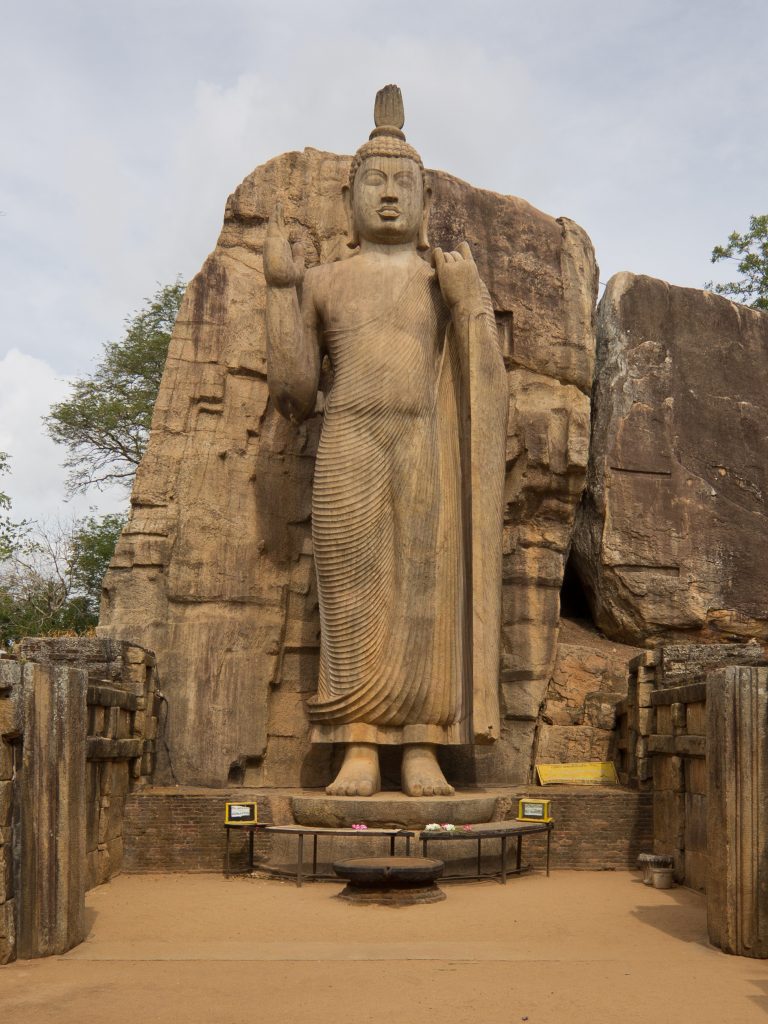Buddhism is one of the world’s major religions and spiritual practices. Buddhism would not exist if it were not for the heightened consciousness of a man named Siddhartha Guatama (563 BCE-483 BCE).1 According to Buddhist legends about Buddha, after many reincarnations, Siddhartha was born into a rich Indian Family, of the Warrior caste, in which he experienced a privileged and wealthy life into his twenties. But Siddhartha abandoned that life for one without material possessions, but filled with spiritual wisdom and insight, all in pursuit of Nirvana, or, Enlightenment.2
According to Buddhist traditions, during the sixth century BCE, a woman had a dream of an elephant entering her body after being offered a lotus flower by the elephant. She was the queen of a small Indian kingdom. She asked the Wise Men what the vision meant. They explained to her that she would have a son who would either be a great conqueror, or a great holy man. Months later Siddhartha Guatama was born and in the subsequent week, the Queen died.3
Siddhartha grew up sheltered by his father. The King wanted him to become the great conqueror and ruler that the Sages had prophesied he could become. Siddhartha lived in luxury at the palace of his family. “I had three palaces: one for the cold season, one for the hot season, one for the rainy season. During the four months of the rainy season I was entertained in the rainy-season palace by minstrels without a single man among them, and I did not once come down from the palace.”4
According to those same traditions, one day Siddhartha told his charioteer to take him out to see the outside world. Siddhartha would take four trips outside before his

renunciation of extravagance and sensual pleasure. On the first trip he saw an old man. After this experience, Siddhartha’s father explained to the charioteer that Siddhartha must not become a holy man as the sages had said he would become. So he continued his attempts to keep Siddhartha in the palace, by fueling the sensual pleasures of his son. The second trip out, Siddhartha witnessed a sick man. On the third trip, Siddhartha came across a corpse, realizing that death is imminent in all of our lives, no matter how abundant or extravagant we live. During Siddhartha’s fourth and final trip out as an Indian prince, he came across a holy man, bald and wearing a yellow robe. Siddhartha asked for an explanation from his chariot driver, to which the charioteer explained the man to be a renunciant. All these experiences outside the palace caused Siddhartha to realize that pain and suffering is inherent to life. He wanted a way out of this cycle of suffering; he realized that all sensual pleasures were vain and short-lived.5 “Even though I was endowed with such fortune, such total refinement, the thought occurred to me: ‘When an untaught, run-of-the-mill person, himself subject to aging, not beyond aging, sees another who is aged, he is horrified, humiliated, & disgusted, oblivious to himself that he too is subject to aging, not beyond aging.”6
Finally, one night at the age of 29, Siddhartha made the hard decision to leave his wife and newborn son, and live as a holy man. He was tempted by Mara, the demon of desire, as he left the palace. Mara presented to him the idea that if he would turn back, he would be a great ruler in the world. Siddhartha rejected Mara’s proposal. He left everything behind, and began his journey towards Enlightenment, towards Nirvana.7
- Jens-Uwe Hartmann, The Dating of the Historical Buddha: Part I (Vandenhoeck & Ruprecht in GÖTTINGEN, 1991) 32; Maha-parinibbana Sutta, Last Days of the Buddha, translated from the Pali by Sister Vajira & Francis Story (Access to Insight (Legacy Edition), 30 November 2013) DN 16. The former source presents the date of death of the Buddha in 483 BCE, while the former explains the death of Buddha at an age of 80, creating a timeframe for his life and death. ↵
- “The Buddha,” PBS Documentary, directed by David Grubin (PBS, 2010), DVD. ↵
- “The Buddha,” PBS Documentary, directed by David Grubin (PBS, 2010), DVD. ↵
- Sukhamala Sutta, Refinement, translated from the Pali by Thanissaro Bhikkhu. (Access to Insight (Legacy Edition), 1 December 2013) AN 3.38; Chris Pauling, Introducing Buddhism (Birmingham: Windhorse Publication, 1990), 5-6. ↵
- E.H. Brewster, The Life of Gotama the Buddha (London: K.Paul, Trench Tubner & Co., 1926), 1-3. ↵
- Sukhamala Sutta, Refinement, translated from the Pali by Thanissaro Bhikkhu. (Access to Insight (Legacy Edition), 1 December 2013) AN 3.38 ↵
- “The Buddha,” PBS Documentary, directed by David Grubin (PBS, 2010), DVD. ↵



40 comments
Alejandra Chavez
As someone who attempts to follow the Buddhist way of life as much as possible, I find quite inspiring that someone who came from a very wealthy beginning decided to give that up in order to find their one true self. That was a very courageous act on Siddhartha’s part. It’s quite easy to be blinded by all things materialistic especially if you don’t come a humble beginning. Great job, looking forward to reading part II.
Andrew Rodriguez
He had a very interesting story as his upbringing. We can see that people can change drastically, no matter of what background. Great minds can see the world in a different way. Someone who was sheltered felt remorse for the unfortunate and saw the harm of the little things in life. That is a major turn around from what he was growing up with in not struggling for anything in life.
Thomas Fraire
Before reading this I had no idea Buddha’s name was not always Buddha. It’s His dad was, it must have been really hard growing up in a sheltered environment like that and not really having a say in you life or where you are heading. Overall this told a very good article and I can’t wait to read the 2nd one.
Alexis Renteria
Its interesting how someone with so many riches would choose to leave everything behind to pursue enlightenment. Something I did not know about the story of the Buddha is that he took four trips before deciding if he wanted to be a great holy man or a great conqueror. I also cant imagine how hard it must have been for Siddhartha to leave behind his wife and his newborn son. Overall this was a very interesting article and it does a well job of telling the story of Buddha.
Maria Callejas
This was a total learning experience for me since I know little about Buddhism. First of all, great introduction! By stating how Siddhartha Gautama abandoned his comfort beginnings to start his quest for spirituality you set an intriguing tone to the rest of your article. You provide very strong evidence that creates meaning throughout the text, specifically when we learn about how Buddha’s father wanted to stop him from becoming “Buddha”. Similarly when we see how devoted he was to the search of Enlightenment, leaving his wife and newborn baby behind. Good job on part 1, can’t wait to read part 2!
Aaiyanna Johnson
Thank you for writing this article. As someone who practices Buddhism I really appreciate the time and effort put into the article. I enjoyed relearning, and even learning new things about Buddhism and Siddhartha. It was enlightening to hear of the beginning. I did not know that he had to make such a hard decision in leaving his wife, and baby son, that takes a lot of willpower.
Rebekah Esquivel
I have heard very little about Buddhism and how the religion came about. This article was very interesting and provided a good story line of how Siddhartha came to start his Journey of Enlightenment. It is shocking how a child who grew up so sheltered and protected was still able to see the true meanings to life for himself and form his own path. As a child he recognized the pain and suffering that was evident in the world and with only four trips out of the palace he was able to see that all the material things were only temporary and not of much importance.
Oceane Roux
Thank you for this amazing article! In my view, Buddhism is incredibly fascinating because it is so different from the religions we have in our society even if there are some similarities, for example, with the principle of resist the temptation and live a simple life. I find this topic very interesting, and I honestly wish I knew more about this religion.
Mario Sosa
I am not familiar with Buddhism, so I found this to be a good article to learn about its origin. It seems almost hard to believe that Siddhartha had three palaces for the three seasons. I wonder what was going through Siddhartha’s mind as he was leaving his family and wealth behind. Very interesting to see where Siddhartha’s story goes from here; great job on the article!
Alyssa Vela
It’s always fun to learn about a religion other than my own! You were able to put so much information into one article, which was great because it wasn’t too much excess reading. It was really cool learning about the Buddha. Overall, this article had great information, I enjoyed your sentence structure. I look forward to reading part 2!